
West Chester University
Digital Commons @ West Chester University
Anthropology & Sociology College of Arts & Sciences
1-1999
West Chester University of Pennsylvania, mbecker@wcupa.edu
Follow this and additional works at: h>p://digitalcommons.wcupa.edu/anthrosoc_facpub
Part of the Archaeological Anthropology Commons
=is Article is brought to you for free and open access by the College of Arts & Sciences at Digital Commons @ West Chester University. It has been
accepted for inclusion in Anthropology & Sociology by an authorized administrator of Digital Commons @ West Chester University. For more
information, please contact wcressler@wcupa.edu.
Recommended Citation
Becker, M. J. (1999). Etruscan Gold Dental Appliances: =ree Newly "Discovered" Examples. American Journal of Archaeology, 103(1),
103-111. h>p://dx.doi.org/10.2307/506579
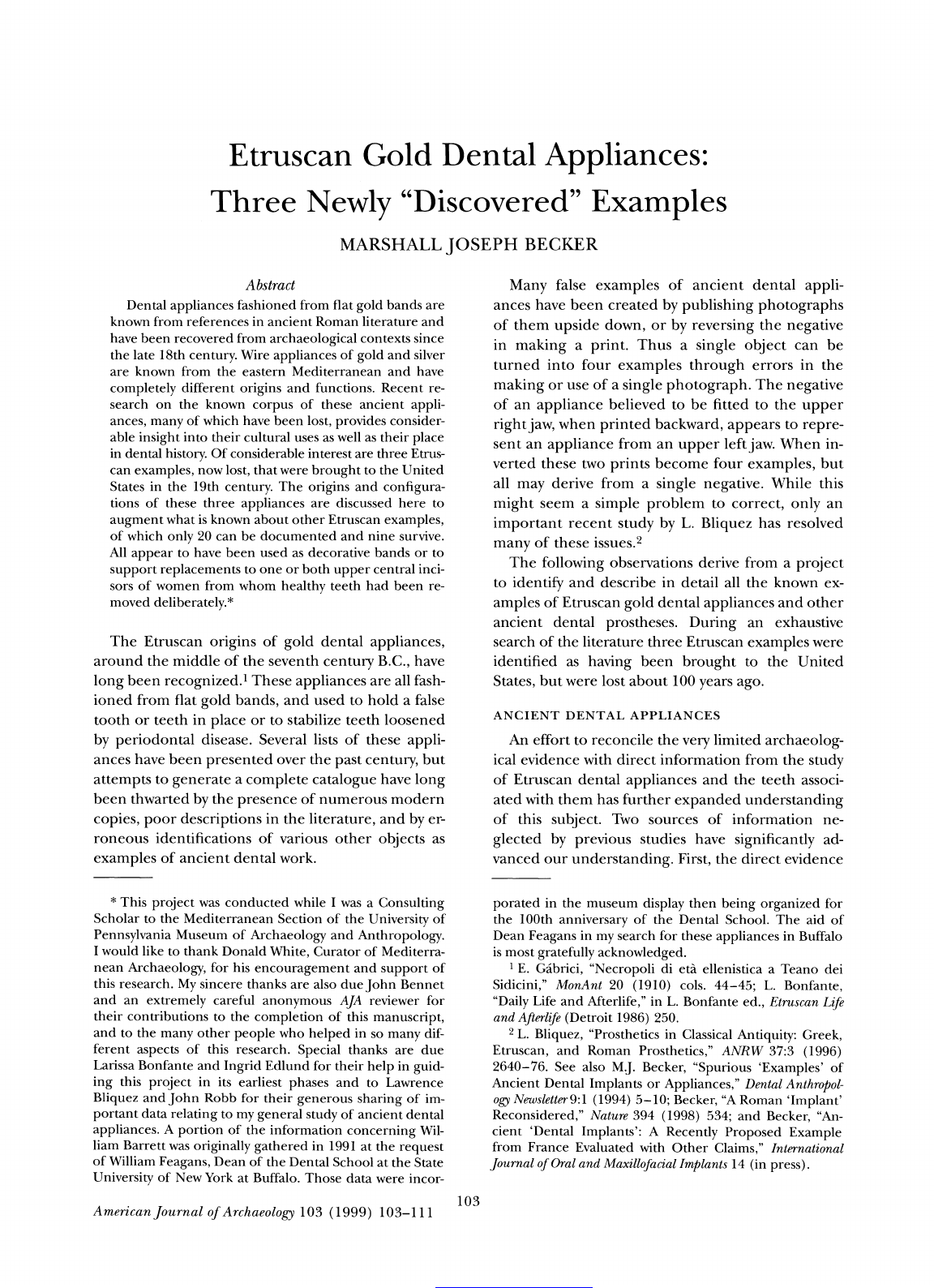
Etruscan
Gold
Dental
Appliances:
Three
Newly
"Discovered"
Examples
MARSHALL
JOSEPH
BECKER
Abstract
Dental
appliances
fashioned from flat
gold
bands
are
known from
references
in
ancient Roman literature and
have been recovered from
archaeological
contexts since
the late
18th
century.
Wire
appliances
of
gold
and
silver
are known from the eastern Mediterranean
and have
completely
different
origins
and functions. Recent re-
search on
the
known
corpus
of these ancient
appli-
ances,
many
of which have been
lost,
provides
consider-
able
insight
into their cultural uses as well as their
place
in
dental
history.
Of
considerable interest are three Etrus-
can
examples,
now
lost,
that were
brought
to the United
States
in
the
19th
century.
The
origins
and
configura-
tions of these three
appliances
are discussed here
to
augment
what
is known
about other Etruscan
examples,
of
which
only
20
can be documented and nine survive.
All
appear
to have been used as decorative bands
or
to
support replacements
to one or both
upper
central inci-
sors of women from
whom
healthy
teeth had been re-
moved
deliberately.*
The Etruscan
origins
of
gold
dental
appliances,
around the
middle
of the seventh
century
B.C.,
have
long
been
recognized.1
These
appliances
are all fash-
ioned from flat
gold
bands,
and used to
hold
a
false
tooth
or
teeth
in
place
or to stabilize teeth loosened
by
periodontal
disease. Several lists of these
appli-
ances have been
presented
over the
past century,
but
attempts
to
generate
a
complete catalogue
have
long
been thwarted
by
the
presence
of numerous modern
copies,
poor descriptions
in
the
literature,
and
by
er-
roneous
identifications
of
various other
objects
as
examples
of ancient dental
work.
Many
false
examples
of ancient dental
appli-
ances have been
created
by
publishing photographs
of
them
upside
down,
or
by reversing
the
negative
in
making
a
print.
Thus a
single object
can
be
turned into four
examples
through
errors in
the
making
or use of
a
single
photograph.
The
negative
of
an
appliance
believed
to be fitted
to the
upper
rightjaw,
when
printed
backward,
appears
to
repre-
sent
an
appliance
from
an
upper
left
jaw.
When
in-
verted these two
prints
become four
examples,
but
all
may
derive from a
single negative.
While
this
might
seem a
simple
problem
to
correct,
only
an
important
recent
study by
L.
Bliquez
has
resolved
many
of
these
issues.2
The
following
observations
derive
from a
project
to
identify
and
describe
in
detail all the
known ex-
amples
of Etruscan
gold
dental
appliances
and
other
ancient dental
prostheses.
During
an
exhaustive
search
of
the literature three Etruscan
examples
were
identified as
having
been
brought
to the United
States,
but
were lost about
100
years ago.
ANCIENT DENTAL
APPLIANCES
An effort
to reconcile the
very
limited
archaeolog-
ical evidence with
direct information from
the
study
of Etruscan dental
appliances
and the teeth
associ-
ated
with
them has further
expanded
understanding
of this
subject.
Two sources of
information ne-
glected by previous
studies
have
significantly
ad-
vanced our
understanding.
First,
the direct
evidence
*
This
project
was
conducted while
I
was
a
Consulting
Scholar
to the
Mediterranean
Section of the
University
of
Pennsylvania
Museum of
Archaeology
and
Anthropology.
I
would like
to thank Donald
White,
Curator of
Mediterra-
nean
Archaeology,
for
his
encouragement
and
support
of
this
research.
My
sincere thanks
are also
due
John
Bennet
and
an
extremely
careful
anonymous
AJA
reviewer for
their
contributions to
the
completion
of
this
manuscript,
and
to the
many
other
people
who
helped
in
so
many
dif-
ferent
aspects
of this
research.
Special
thanks
are due
Larissa
Bonfante and
Ingrid
Edlund
for their
help
in
guid-
ing
this
project
in
its
earliest
phases
and
to
Lawrence
Bliquez
and
John
Robb
for their
generous
sharing
of im-
portant
data
relating
to
my general
study
of
ancient dental
appliances.
A
portion
of
the
information
concerning
Wil-
liam
Barrett was
originally gathered
in
1991 at
the
request
of
William
Feagans,
Dean of
the
Dental
School at
the State
University
of New
York
at
Buffalo.
Those
data were
incor-
porated
in
the museum
display
then
being organized
for
the 100th
anniversary
of the
Dental
School. The aid
of
Dean
Feagans
in
my
search for
these
appliances
in
Buffalo
is most
gratefully
acknowledged.
I
E.
Gaibrici,
"Necropoli
di
eta
ellenistica
a
Teano
dei
Sidicini,"
MonAnt
20
(1910)
cols.
44-45;
L.
Bonfante,
"Daily
Life and
Afterlife,"
in
L.
Bonfante
ed.,
Etruscan
Life
and
Afterlife
(Detroit
1986)
250.
2
L.
Bliquez,
"Prosthetics in
Classical
Antiquity:
Greek,
Etruscan,
and
Roman
Prosthetics,"
ANRW 37:3
(1996)
2640-76. See also
M.J.
Becker,
"Spurious
'Examples'
of
Ancient
Dental
Implants
or
Appliances,"
Dental
Anthropol-
ogy
Newsletter
9:1
(1994)
5-10;
Becker,
"A Roman
'Implant'
Reconsidered,"
Nature
394
(1998)
534;
and
Becker,
"An-
cient
'Dental
Implants':
A
Recently
Proposed
Example
from
France
Evaluated with
Other
Claims,"
International
Journal of
Oral and
Maxillofacial Implants
14
(in
press).
103
American
Journal
of
Archaeology 103
(1999)
103-111
This content downloaded from 144.26.117.20 on Thu, 14 May 2015 18:13:01 UTC
All use subject to JSTOR Terms and Conditions
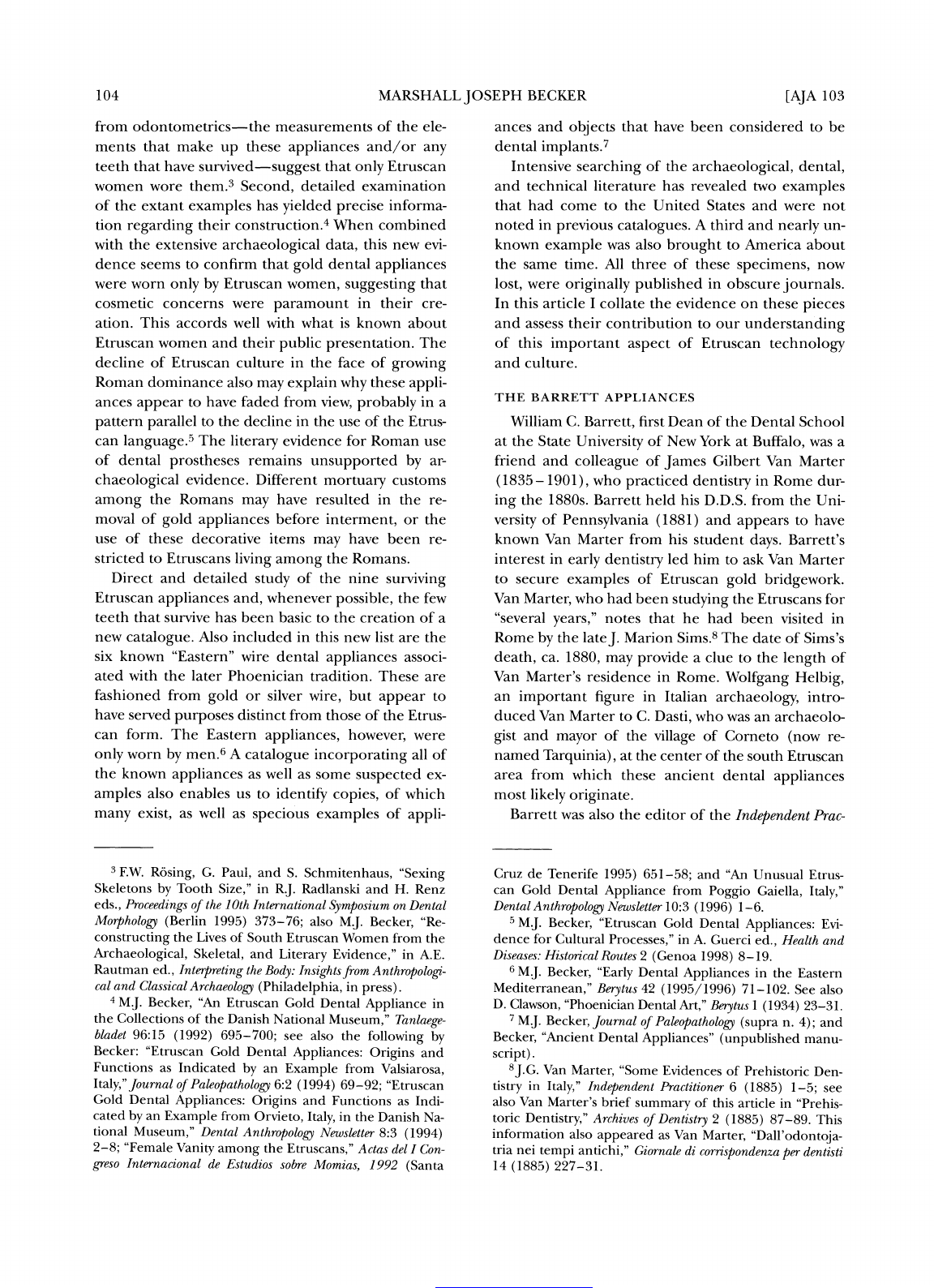
104 MARSHALL
JOSEPH
BECKER
[AJA
103
from
odontometrics-the measurements of the
ele-
ments that make
up
these
appliances
and/or
any
teeth that have
survived-suggest
that
only
Etruscan
women wore
them.3
Second,
detailed
examination
of
the extant
examples
has
yielded precise
informa-
tion
regarding
their
construction.4
When
combined
with the extensive
archaeological
data,
this new
evi-
dence seems to confirm that
gold
dental
appliances
were worn
only by
Etruscan
women,
suggesting
that
cosmetic concerns were
paramount
in
their
cre-
ation. This accords
well with what
is
known
about
Etruscan women and their
public presentation.
The
decline
of Etruscan culture
in
the face of
growing
Roman
dominance also
may
explain why
these
appli-
ances
appear
to have faded from
view,
probably
in
a
pattern parallel
to the
decline
in
the use of
the
Etrus-
can
language.5
The
literary
evidence for Roman
use
of dental
prostheses
remains
unsupported by
ar-
chaeological
evidence.
Different
mortuary
customs
among
the
Romans
may
have resulted in
the
re-
moval
of
gold
appliances
before
interment,
or the
use of
these decorative
items
may
have been
re-
stricted to
Etruscans
living among
the
Romans.
Direct and
detailed
study
of the nine
surviving
Etruscan
appliances
and,
whenever
possible,
the
few
teeth that
survive has been
basic to the creation of
a
new
catalogue.
Also
included
in
this
new list are
the
six
known "Eastern"
wire dental
appliances
associ-
ated with the
later
Phoenician tradition.
These
are
fashioned from
gold
or
silver
wire,
but
appear
to
have
served
purposes
distinct from those of
the Etrus-
can form.
The Eastern
appliances,
however,
were
only
worn
by
men.6 A
catalogue
incorporating
all
of
the
known
appliances
as well as
some
suspected
ex-
amples
also
enables us
to
identify
copies,
of
which
many
exist,
as well
as
specious
examples
of
appli-
ances
and
objects
that
have been considered
to
be
dental
implants.7
Intensive
searching
of the
archaeological,
dental,
and technical
literature
has revealed
two
examples
that
had
come to
the United
States
and were
not
noted
in
previous
catalogues.
A third
and
nearly
un-
known
example
was also
brought
to
America
about
the same
time.
All three
of these
specimens,
now
lost,
were
originally
published
in
obscure
journals.
In this article
I
collate
the evidence
on these
pieces
and assess
their
contribution
to our
understanding
of this
important
aspect
of Etruscan
technology
and culture.
THE
BARRETT
APPLIANCES
William
C.
Barrett,
first Dean
of the Dental
School
at the
State
University
of New York
at
Buffalo,
was
a
friend
and
colleague
of
James
Gilbert
Van
Marter
(1835
-
1901),
who
practiced
dentistry
in Rome
dur-
ing
the
1880s.
Barrett
held
his D.D.S.
from
the
Uni-
versity
of
Pennsylvania
(1881)
and
appears
to
have
known
Van Marter
from
his student
days.
Barrett's
interest
in
early dentistry
led
him to
ask Van
Marter
to
secure
examples
of Etruscan
gold bridgework.
Van
Marter,
who had
been
studying
the Etruscans
for
"several
years,"
notes
that
he had
been visited
in
Rome
by
the
lateJ.
Marion
Sims.8
The
date
of
Sims's
death,
ca.
1880,
may provide
a
clue
to the
length
of
Van Marter's
residence
in
Rome.
Wolfgang
Helbig,
an
important
figure
in Italian
archaeology,
intro-
duced
Van Marter
to
C.
Dasti,
who
was
an
archaeolo-
gist
and
mayor
of
the
village
of
Corneto
(now
re-
named
Tarquinia),
at
the center of
the
south
Etruscan
area
from which
these
ancient
dental
appliances
most
likely
originate.
Barrett
was
also the
editor of
the
Independent
Prac-
3
F.W.
R6sing,
G.
Paul,
and
S.
Schmitenhaus,
"Sexing
Skeletons
by
Tooth
Size,"
in
R.J.
Radlanski
and H.
Renz
eds.,
Proceedings of
the
10th
International
Symposium
on
Dental
Morphology
(Berlin
1995)
373-76;
also
M.J.
Becker,
"Re-
constructing
the Lives of
South
Etruscan
Women from
the
Archaeological,
Skeletal,
and
Literary
Evidence,"
in
A.E.
Rautman
ed.,
Interpreting
the
Body:
Insights from
Anthropologi-
cal and
Classical
Archaeology
(Philadelphia,
in
press).
4
M.J.
Becker,
"An
Etruscan
Gold
Dental
Appliance
in
the
Collections of
the
Danish
National
Museum,"
Tanlaege-
bladet
96:15
(1992)
695-700;
see
also
the
following by
Becker:
"Etruscan
Gold
Dental
Appliances:
Origins
and
Functions
as
Indicated
by
an
Example
from
Valsiarosa,
Italy,"
Journal
of
Paleopathology
6:2
(1994)
69-92;
"Etruscan
Gold
Dental
Appliances:
Origins
and
Functions as
Indi-
cated
by
an
Example
from
Orvieto,
Italy,
in
the
Danish
Na-
tional
Museum,"
Dental
Anthropology
Newsletter
8:3
(1994)
2-8;
"Female
Vanity
among
the
Etruscans,"
Actas
del
I
Con-
greso
Internacional
de
Estudios sobre
Momias,
1992
(Santa
Cruz
de Tenerife
1995)
651-58;
and
"An
Unusual
Etrus-
can
Gold Dental
Appliance
from
Poggio
Gaiella,
Italy,"
Dental
Anthropology
Newsletter
10:3
(1996)
1-6.
5
M.J.
Becker,
"Etruscan Gold
Dental
Appliances:
Evi-
dence
for
Cultural
Processes,"
in
A. Guerci
ed.,
Health
and
Diseases:
Historical
Routes
2
(Genoa
1998)
8-19.
6
M.J.
Becker,
"Early
Dental
Appliances
in
the
Eastern
Mediterranean,"
Berytus
42
(1995/1996)
71-102.
See
also
D.
Clawson,
"Phoenician
Dental
Art,"
Berytus
1
(1934)
23-31.
7
M.J.
Becker,
Journal
of
Paleopathology (supra
n.
4);
and
Becker,
"Ancient
Dental
Appliances"
(unpublished
manu-
script).
8J.G.
Van
Marter,
"Some
Evidences of
Prehistoric
Den-
tistry
in
Italy,"
Independent
Practitioner
6
(1885)
1-5;
see
also
Van
Marter's
brief
summary
of
this
article in
"Prehis-
toric
Dentistry,"
Archives
of
Dentistry
2
(1885)
87-89.
This
information
also
appeared
as Van
Marter,
"Dall'odontoja-
tria nei
tempi
antichi,"
Giornale
di
corrispondenza
per
dentisti
14
(1885)
227-31.
This content downloaded from 144.26.117.20 on Thu, 14 May 2015 18:13:01 UTC
All use subject to JSTOR Terms and Conditions
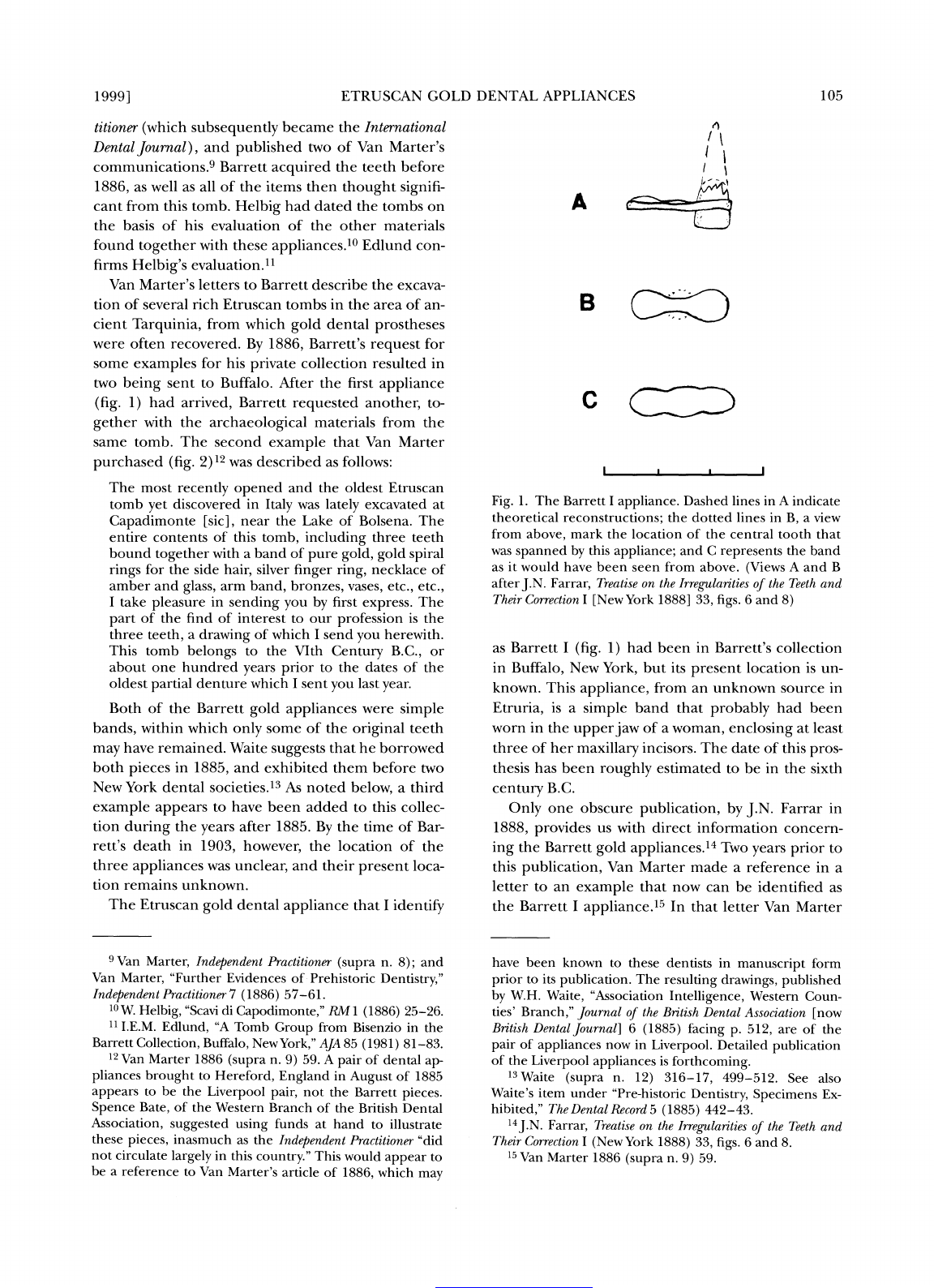
1999]
ETRUSCAN GOLD
DENTAL
APPLIANCES
105
titioner
(which
subsequently
became
the
International
DentalJournal),
and
published
two of
Van
Marter's
communications.9
Barrett
acquired
the teeth
before
1886,
as
well
as all of the items then
thought
signifi-
cant from this
tomb.
Helbig
had dated
the
tombs
on
the basis of his evaluation of the other materials
found
together
with these
appliances.10
Edlund con-
firms
Helbig's
evaluation.11
Van
Marter's letters to
Barrett describe the excava-
tion of several rich
Etruscan tombs
in
the area of
an-
cient
Tarquinia,
from
which
gold
dental
prostheses
were
often recovered.
By
1886,
Barrett's
request
for
some
examples
for his
private
collection resulted
in
two
being
sent
to
Buffalo.
After
the
first
appliance
(fig.
1)
had
arrived,
Barrett
requested
another,
to-
gether
with the
archaeological
materials from
the
same tomb. The
second
example
that Van
Marter
purchased
(fig.
2)12
was described
as follows:
The most
recently
opened
and the oldest Etruscan
tomb
yet
discovered
in
Italy
was
lately
excavated at
Capadimonte
[sic],
near the Lake of
Bolsena.
The
entire contents
of
this
tomb,
including
three teeth
bound
together
with a band
of
pure gold,
gold
spiral
rings
for the side
hair,
silver
finger
ring,
necklace of
amber
and
glass,
arm
band, bronzes,
vases, etc.,
etc.,
I
take
pleasure
in
sending
you by
first
express.
The
part
of
the find of interest to our
profession
is the
three
teeth,
a
drawing
of
which
I
send
you
herewith.
This tomb
belongs
to the
VIth
Century
B.C.,
or
about one hundred
years prior
to
the
dates
of
the
oldest
partial
denture
which I sent
you
last
year.
Both of the
Barrett
gold appliances
were
simple
bands,
within which
only
some of the
original
teeth
may
have remained.
Waite
suggests
that he
borrowed
both
pieces
in
1885,
and
exhibited them before
two
New York dental
societies.13
As noted
below,
a third
example
appears
to
have been
added to
this
collec-
tion
during
the
years
after 1885.
By
the time of Bar-
rett's
death
in
1903,
however,
the
location of
the
three
appliances
was
unclear,
and their
present
loca-
tion
remains
unknown.
The Etruscan
gold
dental
appliance
that I
identify
as Barrett
I
(fig.
1)
had been
in Barrett's
collection
in
Buffalo,
New
York,
but its
present
location is
un-
known.
This
appliance,
from an unknown
source
in
Etruria,
is a
simple
band that
probably
had been
worn in the
upperjaw
of a
woman,
enclosing
at
least
three of
her
maxillary
incisors. The date
of this
pros-
thesis has
been
roughly
estimated to be
in
the sixth
century
B.C.
Only
one
obscure
publication,
by J.N.
Farrar
in
1888,
provides
us
with direct
information
concern-
ing
the
Barrett
gold
appliances.14
Two
years
prior
to
this
publication,
Van
Marter
made
a
reference
in
a
letter to an
example
that
now can
be
identified as
the
Barrett
I
appliance.15
In
that
letter Van
Marter
!
l
I
i
A
B
cccD
I
I
I
Fig.
1. The Barrett
I
appliance.
Dashed
lines
in A
indicate
theoretical
reconstructions;
the
dotted lines
in
B,
a
view
from
above,
mark the location
of the central
tooth
that
was
spanned
by
this
appliance;
and
C
represents
the
band
as it would
have been
seen from above.
(Views
A and
B
after
J.N.
Farrar,
Treatise
on the
Irregularities
of
the Teeth
and
Their Correction
I
[New
York
1888]
33,
figs.
6
and
8)
9
Van
Marter,
Independent
Practitioner
(supra
n.
8);
and
Van
Marter,
"Further
Evidences
of
Prehistoric
Dentistry,"
Independent
Practitioner
7
(1886)
57-61.
10
W.
Helbig,
"Scavi di
Capodimonte,"
RM 1
(1886)
25-26.
"11
I.E.M.
Edlund,
"A
Tomb
Group
from Bisenzio in
the
Barrett
Collection,
Buffalo,
NewYork,"
AJA
85
(1981)
81-83.
12
Van Marter
1886
(supra
n.
9)
59. A
pair
of
dental
ap-
pliances
brought
to
Hereford,
England
in
August
of
1885
appears
to
be the
Liverpool pair,
not
the
Barrett
pieces.
Spence
Bate,
of
the
Western
Branch
of
the British
Dental
Association,
suggested
using
funds at
hand
to
illustrate
these
pieces,
inasmuch as
the
Independent
Practitioner "did
not
circulate
largely
in
this
country."
This
would
appear
to
be
a
reference to Van
Marter's
article of
1886,
which
may
have been
known to
these
dentists
in
manuscript
form
prior
to
its
publication.
The
resulting
drawings, published
by
W.H.
Waite,
"Association
Intelligence,
Western
Coun-
ties'
Branch,"
Journal
of
the British
Dental
Association
[now
British
Dental
Journal]
6
(1885)
facing p.
512,
are of
the
pair
of
appliances
now
in
Liverpool.
Detailed
publication
of
the
Liverpool
appliances
is
forthcoming.
13Waite
(supra
n.
12)
316-17,
499-512.
See
also
Waite's item
under
"Pre-historic
Dentistry,
Specimens
Ex-
hibited,"
The
Dental
Record 5
(1885)
442-43.
14J.N.
Farrar,
Treatise on the
Irregularities
of
the
Teeth
and
Their
Correction I
(New
York
1888)
33,
figs.
6 and
8.
15
Van
Marter
1886
(supra
n.
9)
59.
This content downloaded from 144.26.117.20 on Thu, 14 May 2015 18:13:01 UTC
All use subject to JSTOR Terms and Conditions
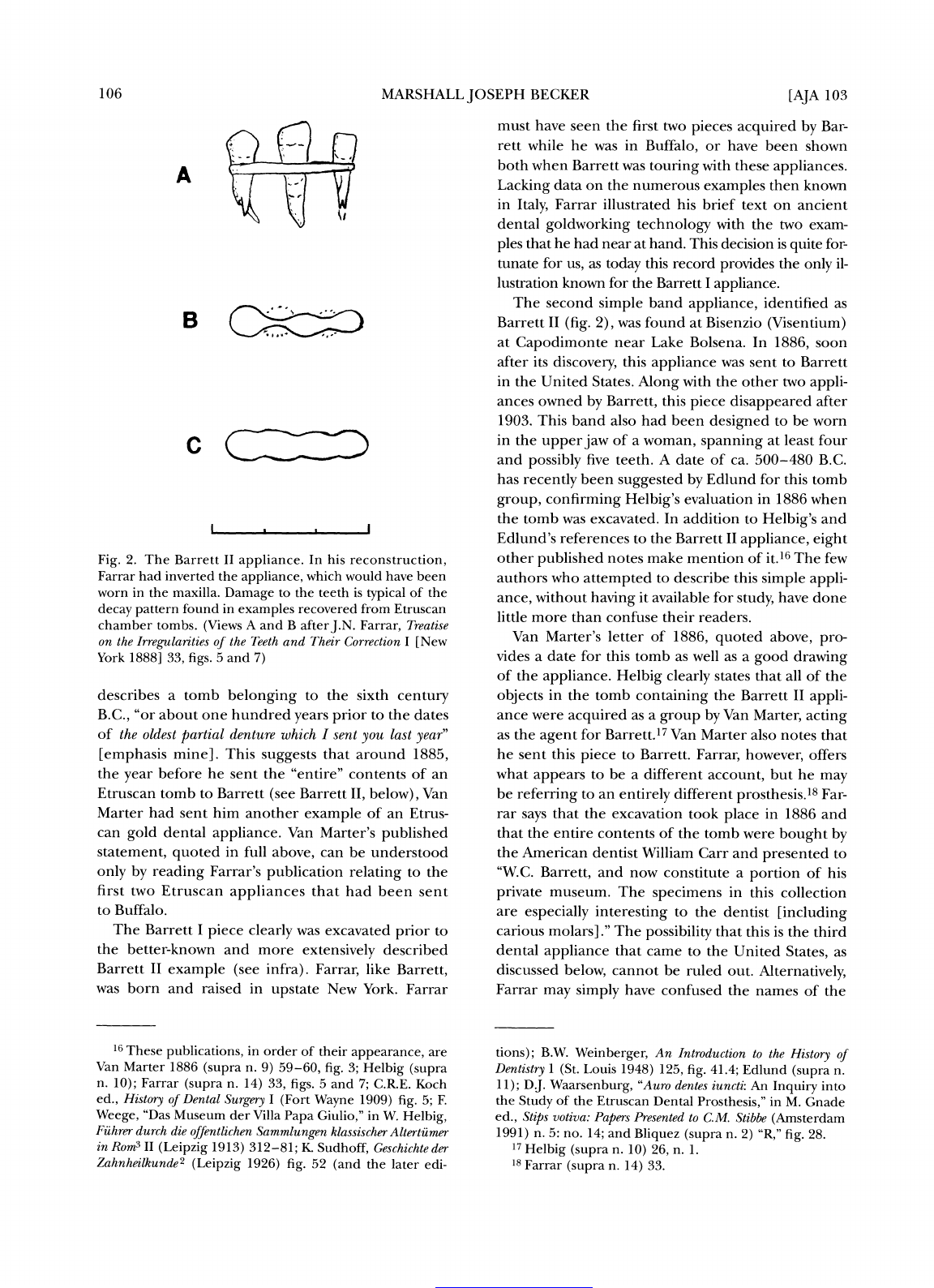
106
MARSHALL
JOSEPH
BECKER
[AJA
103
I
I
B
?)Y
C
Fig.
2.
The
Barrett
II
appliance.
In
his
reconstruction,
Farrar had
inverted the
appliance,
which would
have been
worn
in
the maxilla.
Damage
to the teeth is
typical
of the
decay pattern
found in
examples
recovered from
Etruscan
chamber tombs.
(Views
A and
B
afterJ.N.
Farrar,
Treatise
on the
Irregularities
of
the Teeth
and
Their
Correction
I
[New
York
1888] 33,
figs.
5
and
7)
describes a tomb
belonging
to
the
sixth
century
B.C.,
"or
about one
hundred
years
prior
to the
dates
of the
oldest
partial
denture
which
I
sent
you
last
year"
[emphasis
mine].
This
suggests
that
around
1885,
the
year
before he
sent the "entire"
contents
of an
Etruscan tomb to
Barrett
(see
Barrett
II,
below),
Van
Marter had sent him
another
example
of
an Etrus-
can
gold
dental
appliance.
Van
Marter's
published
statement,
quoted
in
full
above,
can
be
understood
only by
reading
Farrar's
publication
relating
to the
first two
Etruscan
appliances
that
had been sent
to
Buffalo.
The
Barrett I
piece
clearly
was
excavated
prior
to
the
better-known
and
more
extensively
described
Barrett
II
example
(see
infra).
Farrar,
like
Barrett,
was born
and
raised
in
upstate
New York.
Farrar
must have
seen
the first two
pieces acquired
by
Bar-
rett while
he was
in
Buffalo,
or have
been
shown
both when
Barrett
was
touring
with these
appliances.
Lacking
data on
the
numerous
examples
then
known
in
Italy,
Farrar illustrated
his brief
text on
ancient
dental
goldworking
technology
with
the two
exam-
ples
that he had
near at hand.
This decision
is
quite
for-
tunate
for
us,
as
today
this
record
provides
the
only
il-
lustration
known
for the Barrett
I
appliance.
The second
simple
band
appliance,
identified
as
Barrett
II
(fig.
2),
was found
at Bisenzio
(Visentium)
at
Capodimonte
near Lake
Bolsena.
In
1886,
soon
after
its
discovery,
this
appliance
was
sent to
Barrett
in the United
States.
Along
with
the other
two
appli-
ances
owned
by
Barrett,
this
piece
disappeared
after
1903.
This
band also
had been
designed
to be
worn
in the
upper
jaw
of a
woman,
spanning
at least
four
and
possibly
five teeth.
A
date
of ca. 500-480
B.C.
has
recently
been
suggested
by
Edlund
for this
tomb
group, confirming
Helbig's
evaluation
in 1886
when
the tomb
was
excavated.
In
addition
to
Helbig's
and
Edlund's references
to the Barrett
II
appliance, eight
other
published
notes
make mention
of it.16 The
few
authors
who
attempted
to
describe
this
simple
appli-
ance,
without
having
it available
for
study,
have
done
little
more than confuse
their
readers.
Van Marter's
letter
of
1886,
quoted
above,
pro-
vides
a date for
this tomb
as well
as a
good drawing
of
the
appliance.
Helbig clearly
states
that all of
the
objects
in the tomb
containing
the Barrett
II
appli-
ance were
acquired
as a
group by
Van
Marter,
acting
as the
agent
for
Barrett.17
Van Marter
also notes
that
he
sent
this
piece
to
Barrett.
Farrar,
however,
offers
what
appears
to be
a different
account,
but
he
may
be
referring
to an
entirely
different
prosthesis.18
Far-
rar
says
that
the
excavation
took
place
in
1886
and
that the entire
contents
of the tomb
were
bought by
the
American
dentist William
Carr
and
presented
to
"W.C.
Barrett,
and
now
constitute a
portion
of his
private
museum. The
specimens
in
this
collection
are
especially
interesting
to
the
dentist
[including
carious
molars]."
The
possibility
that
this
is
the third
dental
appliance
that came
to
the
United
States,
as
discussed
below,
cannot be
ruled
out.
Alternatively,
Farrar
may
simply
have
confused
the
names
of the
16
These
publications,
in
order
of
their
appearance,
are
Van
Marter
1886
(supra
n.
9)
59-60,
fig.
3;
Helbig (supra
n.
10);
Farrar
(supra
n.
14)
33,
figs.
5
and
7;
C.R.E.
Koch
ed.,
History
of
Dental
Surgery
I
(Fort
Wayne
1909)
fig.
5;
F.
Weege,
"Das
Museum
der
Villa
Papa
Giulio,"
in
W.
Helbig,
Fiihrer
durch
die
offentlichen
Sammlungen
klassischer
Altertiimer
in
Rom3
II
(Leipzig
1913)
312-81;
K.
Sudhoff,
Geschichte
der
Zahnheilkunde2
(Leipzig
1926)
fig.
52
(and
the
later edi-
tions);
B.W.
Weinberger,
An
Introduction to the
History
of
Dentistry
1
(St.
Louis
1948)
125,
fig.
41.4;
Edlund
(supra
n.
11);
D.J.
Waarsenburg,
"Auro
dentes
iuncti: An
Inquiry
into
the
Study
of
the
Etruscan
Dental
Prosthesis,"
in
M.
Gnade
ed.,
Stips
votiva:
Papers
Presented
to
C.M.
Stibbe
(Amsterdam
1991)
n.
5:
no.
14;
and
Bliquez
(supra
n.
2)
"R,"
fig.
28.
17
Helbig
(supra
n.
10)
26,
n.
1.
18
Farrar
(supra
n.
14)
33.
This content downloaded from 144.26.117.20 on Thu, 14 May 2015 18:13:01 UTC
All use subject to JSTOR Terms and Conditions
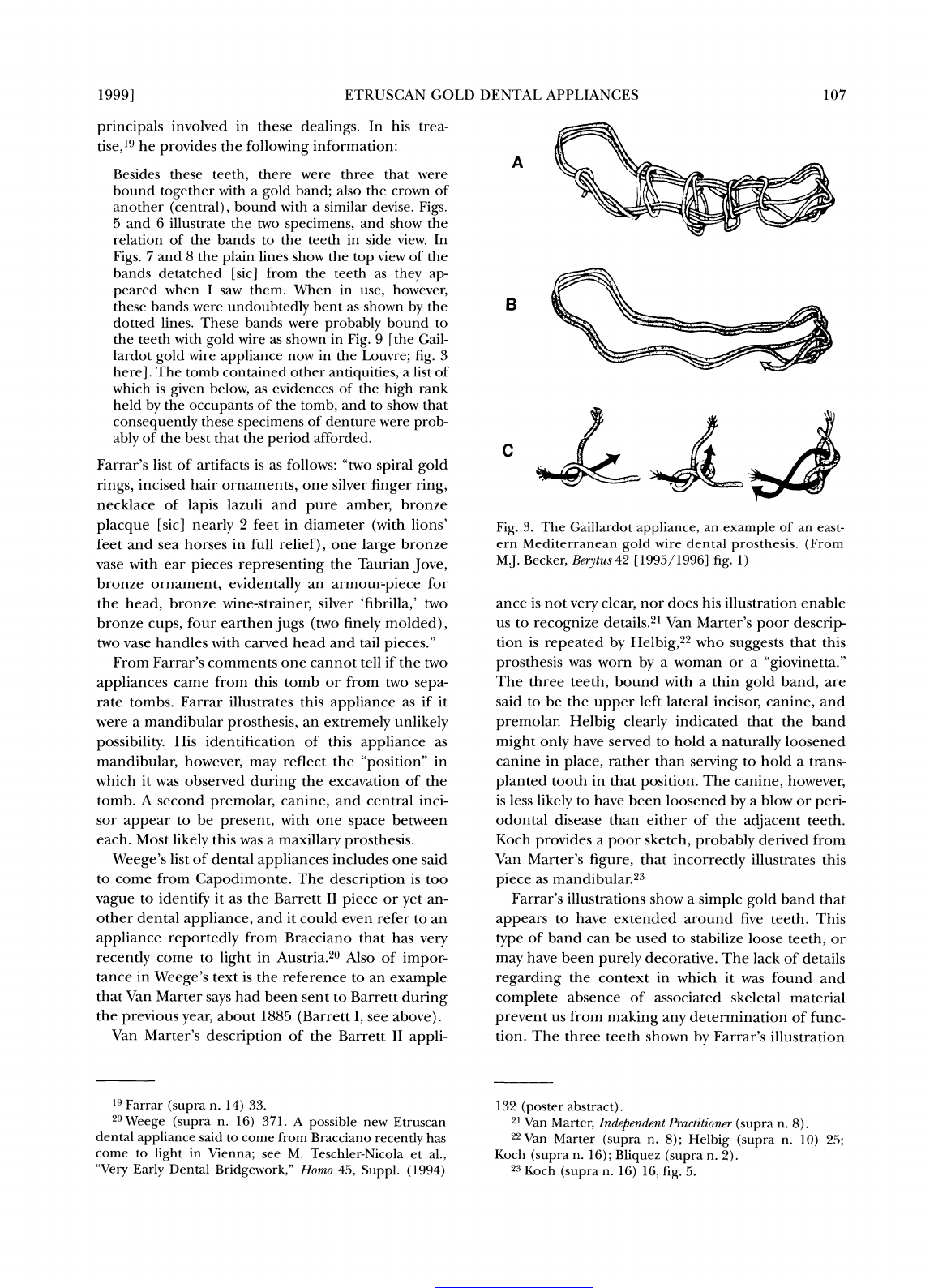
1999]
ETRUSCAN GOLD DENTAL APPLIANCES
107
principals
involved
in these
dealings.
In his
trea-
tise,19
he
provides
the
following
information:
Besides
these
teeth,
there were three that were
bound
together
with
a
gold
band;
also the crown
of
another
(central),
bound with a similar
devise.
Figs.
5 and 6 illustrate the
two
specimens,
and show
the
relation of the bands to the
teeth
in side view. In
Figs.
7 and 8 the
plain
lines show
the
top
view
of the
bands
detatched
[sic]
from the teeth as
they ap-
peared
when
I
saw them.
When
in
use, however,
these bands were
undoubtedly
bent
as shown
by
the
dotted lines. These bands were
probably
bound to
the teeth
with
gold
wire
as
shown
in
Fig.
9
[the
Gail-
lardot
gold
wire
appliance
now
in
the
Louvre;
fig.
3
here].
The tomb contained other
antiquities,
a list of
which
is
given
below,
as evidences of the
high
rank
held
by
the
occupants
of the
tomb,
and to show
that
consequently
these
specimens
of
denture were
prob-
ably
of
the
best
that the
period
afforded.
Farrar's
list of
artifacts
is as follows:
"two
spiral gold
rings,
incised hair
ornaments,
one
silver
finger
ring,
necklace
of
lapis
lazuli and
pure
amber,
bronze
placque
[sic]
nearly
2
feet
in
diameter
(with
lions'
feet
and sea
horses
in
full
relief),
one
large
bronze
vase with ear
pieces representing
the Taurian
Jove,
bronze
ornament,
evidentally
an
armour-piece
for
the
head,
bronze
wine-strainer,
silver
'fibrilla,'
two
bronze
cups,
four
earthen
jugs
(two
finely
molded),
two vase handles with carved head and
tail
pieces."
From Farrar's comments one cannot tell
if
the
two
appliances
came
from
this
tomb or
from two
sepa-
rate tombs.
Farrar
illustrates this
appliance
as
if it
were a mandibular
prosthesis,
an
extremely unlikely
possibility.
His
identification of this
appliance
as
mandibular, however,
may
reflect the
"position"
in
which
it
was
observed
during
the
excavation of
the
tomb.
A
second
premolar,
canine,
and central inci-
sor
appear
to be
present,
with one
space
between
each. Most
likely
this was a
maxillary prosthesis.
Weege's
list
of
dental
appliances
includes one
said
to come from
Capodimonte.
The
description
is
too
vague
to
identify
it
as
the Barrett
II
piece
or
yet
an-
other
dental
appliance,
and it
could even refer to
an
appliance
reportedly
from
Bracciano
that has
very
recently
come to
light
in
Austria.20
Also
of
impor-
tance
in
Weege's
text is the
reference
to
an
example
that
Van Marter
says
had been
sent to
Barrett
during
the
previous
year,
about 1885
(Barrett
I,
see
above).
Van
Marter's
description
of
the
Barrett II
appli-
ance
is not
very
clear,
nor
does
his
illustration enable
us to
recognize
details.2'
Van Marter's
poor descrip-
tion is
repeated
by
Helbig,22
who
suggests
that this
prosthesis
was worn
by
a woman
or
a
"giovinetta."
The
three
teeth,
bound
with
a thin
gold
band,
are
said
to
be the
upper
left lateral
incisor,
canine,
and
premolar. Helbig clearly
indicated that the band
might
only
have served
to
hold a
naturally
loosened
canine
in
place,
rather
than
serving
to hold a
trans-
planted
tooth in
that
position.
The
canine,
however,
is less
likely
to
have been
loosened
by
a blow or
peri-
odontal
disease
than
either
of
the
adjacent
teeth.
Koch
provides
a
poor
sketch,
probably
derived
from
Van Marter's
figure,
that
incorrectly
illustrates this
piece
as
mandibular.23
Farrar's
illustrations
show
a
simple gold
band that
appears
to have
extended
around five teeth.
This
type
of
band can be
used to stabilize
loose
teeth,
or
may
have been
purely
decorative. The
lack of
details
regarding
the
context
in
which it
was
found
and
complete
absence
of
associated
skeletal
material
prevent
us from
making any
determination of func-
tion.
The
three teeth
shown
by
Farrar's
illustration
A
C
Fig.
3.
The
Gaillardot
appliance,
an
example
of
an east-
ern Mediterranean
gold
wire dental
prosthesis.
(From
M.J.
Becker,
Berytus
42
[1995/1996]
fig.
1)
19
Farrar
(supra
n.
14)
33.
20Weege
(supra
n.
16)
371.
A
possible
new
Etruscan
dental
appliance
said to
come from
Bracciano
recently
has
come to
light
in
Vienna;
see M.
Teschler-Nicola et
al.,
"Very
Early
Dental
Bridgework,"
Homo
45,
Suppl.
(1994)
132
(poster
abstract).
21
Van
Marter,
Independent
Practitioner
(supra
n.
8).
22Van
Marter
(supra
n.
8);
Helbig
(supra
n.
10)
25;
Koch
(supra
n.
16);
Bliquez
(supra
n.
2).
23
Koch
(supra
n.
16)
16,
fig.
5.
This content downloaded from 144.26.117.20 on Thu, 14 May 2015 18:13:01 UTC
All use subject to JSTOR Terms and Conditions
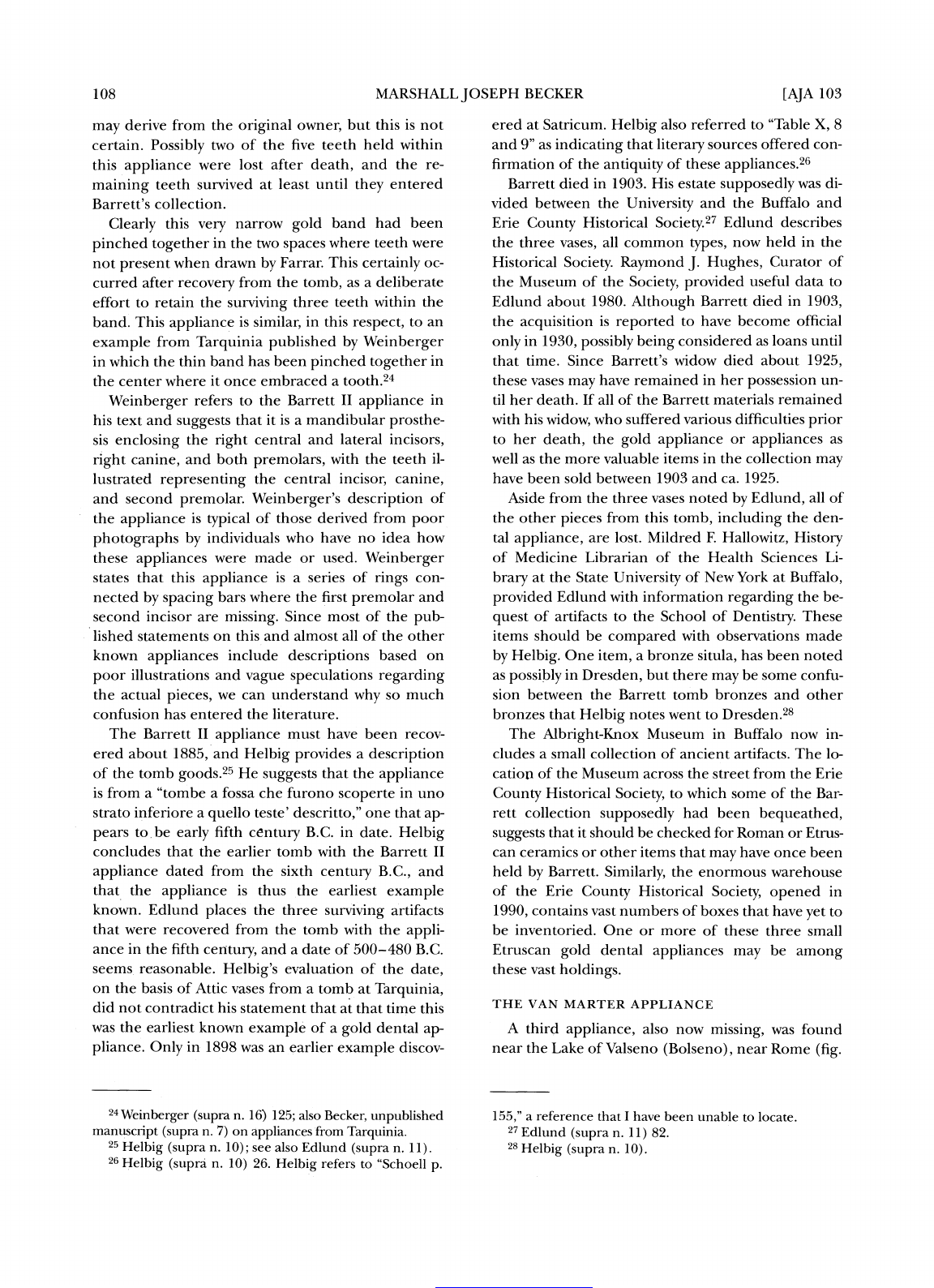
108
MARSHALL
JOSEPH
BECKER
[AJA
103
may
derive
from the
original
owner,
but
this is not
certain.
Possibly
two
of the five teeth held
within
this
appliance
were
lost
after
death,
and the
re-
maining
teeth
survived at
least
until
they
entered
Barrett's
collection.
Clearly
this
very
narrow
gold
band had
been
pinched together
in
the two
spaces
where teeth were
not
present
when
drawn
by
Farrar.
This
certainly
oc-
curred after
recovery
from
the
tomb,
as a
deliberate
effort
to retain the
surviving
three teeth within
the
band.
This
appliance
is
similar,
in this
respect,
to
an
example
from
Tarquinia
published
by Weinberger
in
which
the
thin band has
been
pinched together
in
the center where
it once embraced a
tooth.24
Weinberger
refers to the Barrett
II
appliance
in
his
text and
suggests
that
it
is
a mandibular
prosthe-
sis
enclosing
the
right
central and
lateral
incisors,
right
canine,
and
both
premolars,
with the teeth
il-
lustrated
representing
the central
incisor,
canine,
and second
premolar. Weinberger's
description
of
the
appliance
is
typical
of those derived
from
poor
photographs
by
individuals
who have
no
idea
how
these
appliances
were
made
or used.
Weinberger
states that this
appliance
is
a series
of
rings
con-
nected
by
spacing
bars
where the
first
premolar
and
second
incisor
are
missing.
Since most
of the
pub-
lished statements
on
this and almost
all of the other
known
appliances
include
descriptions
based
on
poor
illustrations and
vague speculations regarding
the actual
pieces,
we can
understand
why
so much
confusion
has entered
the literature.
The
Barrett
II
appliance
must have
been
recov-
ered about
1885,
and
Helbig provides
a
description
of
the
tomb
goods.25
He
suggests
that the
appliance
is from a "tombe a
fossa
che furono
scoperte
in
uno
strato
inferiore
a
quello
teste'
descritto,"
one
that
ap-
pears
to.be
early
fifth
century
B.C.
in
date.
Helbig
concludes
that the
earlier tomb with the
Barrett
II
appliance
dated
from
the sixth
century
B.C.,
and
that the
appliance
is thus
the
earliest
example
known.
Edlund
places
the
three
surviving
artifacts
that
were
recovered from
the tomb with
the
appli-
ance
in
the
fifth
century,
and a date of
500-480 B.C.
seems
reasonable.
Helbig's
evaluation of
the
date,
on
the basis of
Attic
vases
from
a tomb
at
Tarquinia,
did not
contradict his
statement
that at that time
this
was the
earliest known
example
of
a
gold
dental
ap-
pliance.
Only
in
1898 was
an earlier
example
discov-
ered
at
Satricum.
Helbig
also referred
to "Table
X,
8
and 9"
as
indicating
that
literary
sources offered
con-
firmation
of
the
antiquity
of these
appliances.26
Barrett died
in 1903. His estate
supposedly
was
di-
vided between
the
University
and
the Buffalo
and
Erie
County
Historical
Society.27
Edlund
describes
the
three
vases,
all
common
types,
now held in
the
Historical
Society. Raymond
J. Hughes,
Curator
of
the Museum of
the
Society, provided
useful data
to
Edlund about
1980.
Although
Barrett
died
in
1903,
the
acquisition
is
reported
to have become
official
only
in
1930,
possibly
being
considered
as loans until
that
time. Since Barrett's
widow died
about
1925,
these vases
may
have remained
in her
possession
un-
til her death. If all
of the Barrett materials
remained
with
his
widow,
who suffered
various
difficulties
prior
to her
death,
the
gold appliance
or
appliances
as
well as the more valuable
items
in the collection
may
have been sold between
1903 and ca.
1925.
Aside
from the three vases
noted
by
Edlund,
all of
the other
pieces
from
this
tomb,
including
the den-
tal
appliance,
are lost.
Mildred
F.
Hallowitz,
History
of
Medicine Librarian
of
the
Health Sciences
Li-
brary
at the State
University
of New York at
Buffalo,
provided
Edlund with information
regarding
the
be-
quest
of
artifacts
to the School
of
Dentistry.
These
items
should
be
compared
with observations
made
by
Helbig.
One
item,
a bronze
situla,
has been
noted
as
possibly
in
Dresden,
but
there
may
be
some
confu-
sion
between
the
Barrett tomb
bronzes
and other
bronzes that
Helbig
notes went to
Dresden.28
The
Albright-Knox
Museum in
Buffalo now
in-
cludes
a small
collection
of
ancient artifacts. The lo-
cation
of the Museum
across the street
from
the
Erie
County
Historical
Society,
to which some of
the Bar-
rett
collection
supposedly
had been
bequeathed,
suggests
that
it should be
checked
for
Roman
or
Etrus-
can ceramics
or other items
that
may
have once
been
held
by
Barrett.
Similarly,
the enormous
warehouse
of
the Erie
County
Historical
Society,
opened
in
1990,
contains vast numbers of
boxes
that have
yet
to
be
inventoried.
One
or more
of these
three
small
Etruscan
gold
dental
appliances may
be
among
these vast
holdings.
THE
VAN
MARTER
APPLIANCE
A
third
appliance,
also
now
missing,
was
found
near the
Lake of
Valseno
(Bolseno),
near
Rome
(fig.
24
Weinberger
(supra
n.
16)
125;
also
Becker,
unpublished
manuscript
(supra
n.
7)
on
appliances
from
Tarquinia.
25
Helbig
(supra
n.
10);
see
also
Edlund
(supra
n.
11).
26
Helbig
(supra
n.
10)
26.
Helbig
refers to
"Schoell
p.
155,"
a
reference
that
I
have
been
unable
to locate.
27
Edlund
(supra
n.
11)
82.
28
Helbig
(supra
n.
10).
This content downloaded from 144.26.117.20 on Thu, 14 May 2015 18:13:01 UTC
All use subject to JSTOR Terms and Conditions
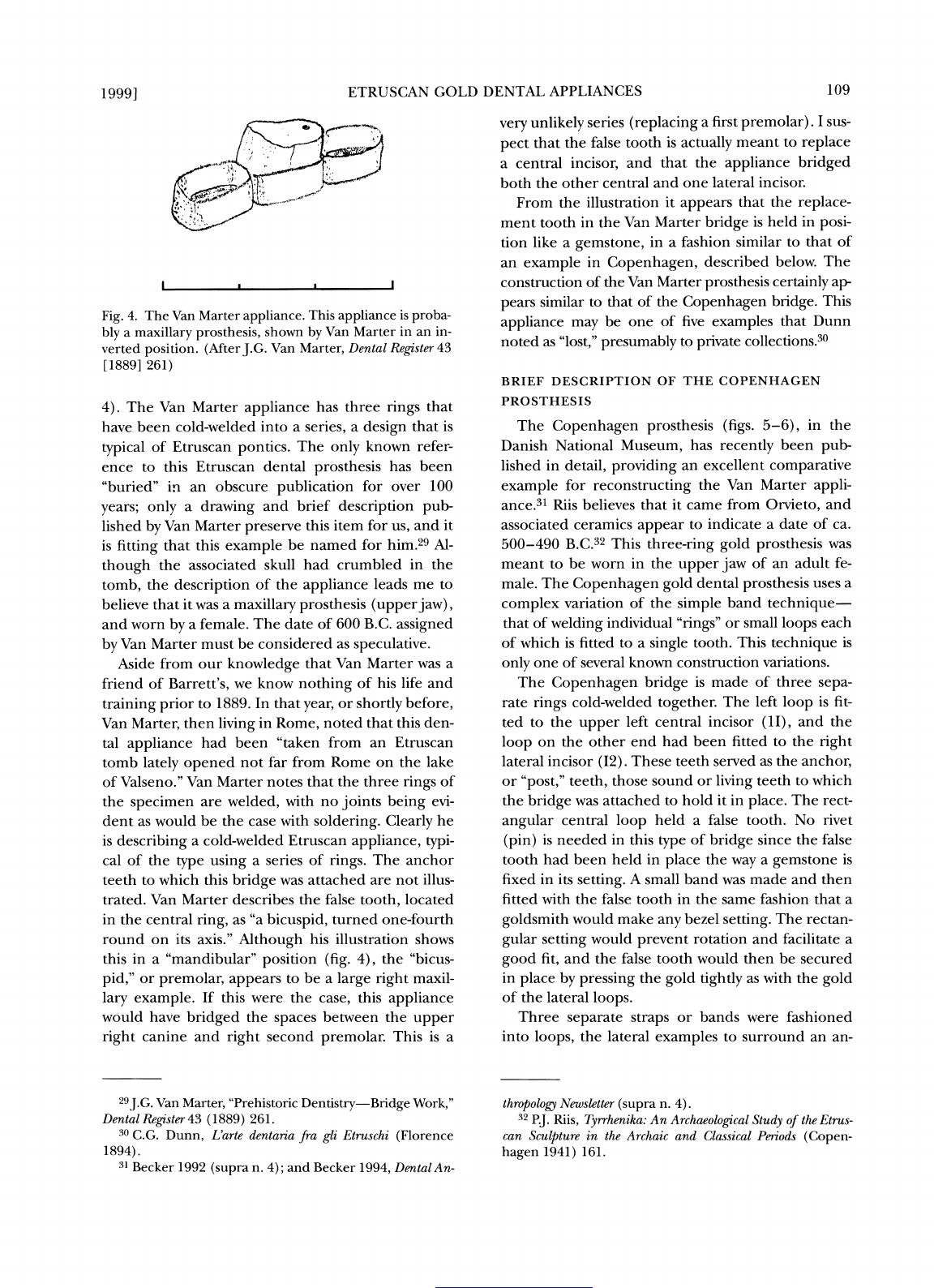
1999]
ETRUSCAN GOLD
DENTAL APPLIANCES
109
Q ~~r~u~~
:? ~ tl`?
i -
:"t~CI\:Ft.
t~ ?';!(
I I , I
Fig.
4. The Van
Marter
appliance.
This
appliance
is
proba-
bly
a
maxillary prosthesis,
shown
by
Van Marter
in an
in-
verted
position.
(After
J.G.
Van
Marter,
Dental
Register
43
[1889] 261)
4).
The Van
Marter
appliance
has
three
rings
that
have
been cold-welded
into
a
series,
a
design
that is
typical
of
Etruscan
pontics.
The
only
known refer-
ence
to this
Etruscan
dental
prosthesis
has
been
"buried"
in
an obscure
publication
for over
100
years;
only
a
drawing
and brief
description
pub-
lished
by
Van
Marter
preserve
this
item for
us,
and
it
is
fitting
that this
example
be named for
him.29
Al-
though
the associated
skull
had crumbled
in the
tomb,
the
description
of the
appliance
leads
me to
believe that
it
was
a
maxillary prosthesis
(upperjaw),
and worn
by
a female.
The date of
600
B.C.
assigned
by
Van
Marter must
be considered
as
speculative.
Aside
from our
knowledge
that Van Marter
was a
friend of
Barrett's,
we know
nothing
of his
life and
training prior
to
1889. In that
year,
or
shortly
before,
Van
Marter,
then
living
in
Rome,
noted that this
den-
tal
appliance
had been
"taken from
an Etruscan
tomb
lately opened
not far from Rome
on the lake
of
Valseno." Van
Marter notes
that the three
rings
of
the
specimen
are
welded,
with no
joints
being
evi-
dent as would
be the
case
with
soldering.
Clearly
he
is
describing
a
cold-welded
Etruscan
appliance, typi-
cal
of the
type
using
a series of
rings.
The
anchor
teeth to which
this
bridge
was attached
are
not illus-
trated.
Van Marter
describes
the false
tooth,
located
in
the central
ring,
as "a
bicuspid,
turned one-fourth
round on its axis."
Although
his illustration shows
this
in
a "mandibular"
position (fig.
4),
the
"bicus-
pid,"
or
premolar, appears
to be a
large right
maxil-
lary
example.
If this were
the
case,
this
appliance
would have
bridged
the
spaces
between
the
upper
right
canine and
right
second
premolar.
This
is
a
very
unlikely
series
(replacing
a
first
premolar).
I
sus-
pect
that
the false
tooth
is
actually
meant to
replace
a
central
incisor,
and
that
the
appliance
bridged
both the other
central
and
one lateral
incisor.
From
the
illustration
it
appears
that
the
replace-
ment tooth
in
the
Van
Marter
bridge
is held
in
posi-
tion
like a
gemstone,
in a fashion similar
to that
of
an
example
in
Copenhagen,
described
below.
The
construction
of
the
Van
Marter
prosthesis
certainly
ap-
pears
similar
to
that of the
Copenhagen
bridge.
This
appliance
may
be one
of five
examples
that Dunn
noted
as
"lost,"
presumably
to
private
collections.30
BRIEF DESCRIPTION
OF
THE
COPENHAGEN
PROSTHESIS
The
Copenhagen
prosthesis
(figs.
5-6),
in
the
Danish
National
Museum,
has
recently
been
pub-
lished
in
detail,
providing
an excellent
comparative
example
for
reconstructing
the Van
Marter
appli-
ance.31 Riis
believes
that it came
from
Orvieto,
and
associated
ceramics
appear
to indicate
a date
of
ca.
500-490
B.C.32 This
three-ring gold prosthesis
was
meant to
be worn
in the
upper
jaw
of
an adult
fe-
male. The
Copenhagen
gold
dental
prosthesis
uses
a
complex
variation of the
simple
band
technique-
that of
welding
individual
"rings"
or
small
loops
each
of which is fitted
to a
single
tooth. This
technique
is
only
one of several
known construction
variations.
The
Copenhagen
bridge
is
made of three
sepa-
rate
rings
cold-welded
together.
The
left
loop
is
fit-
ted to the
upper
left central
incisor
(11),
and the
loop
on the other
end had
been fitted to
the
right
lateral incisor
(I2).
These
teeth
served
as
the
anchor,
or
"post,"
teeth,
those sound or
living
teeth to which
the
bridge
was
attached to hold
it in
place.
The rect-
angular
central
loop
held a false tooth. No
rivet
(pin)
is
needed
in
this
type
of
bridge
since
the false
tooth had
been
held
in
place
the
way
a
gemstone
is
fixed
in
its
setting.
A
small
band was made and then
fitted
with the
false tooth
in the
same fashion
that a
goldsmith
would make
any
bezel
setting.
The rectan-
gular setting
would
prevent
rotation and facilitate
a
good
fit,
and the false tooth
would
then be
secured
in
place by pressing
the
gold tightly
as with
the
gold
of the
lateral
loops.
Three
separate
straps
or
bands
were fashioned
into
loops,
the lateral
examples
to surround an an-
29J.G.
Van
Marter,
"Prehistoric
Dentistry--Bridge
Work,"
Dental
Register
43
(1889)
261.
30
C.G.
Dunn,
L'arte
dentaria
fra gli
Etruschi
(Florence
1894).
31
Becker
1992
(supra
n.
4);
and Becker
1994,
DentalAn-
thropology
Newsletter
(supra
n.
4).
32
P.J.
Riis,
Tyrrhenika:
An
Archaeological
Study
of
the Etrus-
can
Sculpture
in the Archaic
and Classical
Periods
(Copen-
hagen
1941)
161.
This content downloaded from 144.26.117.20 on Thu, 14 May 2015 18:13:01 UTC
All use subject to JSTOR Terms and Conditions
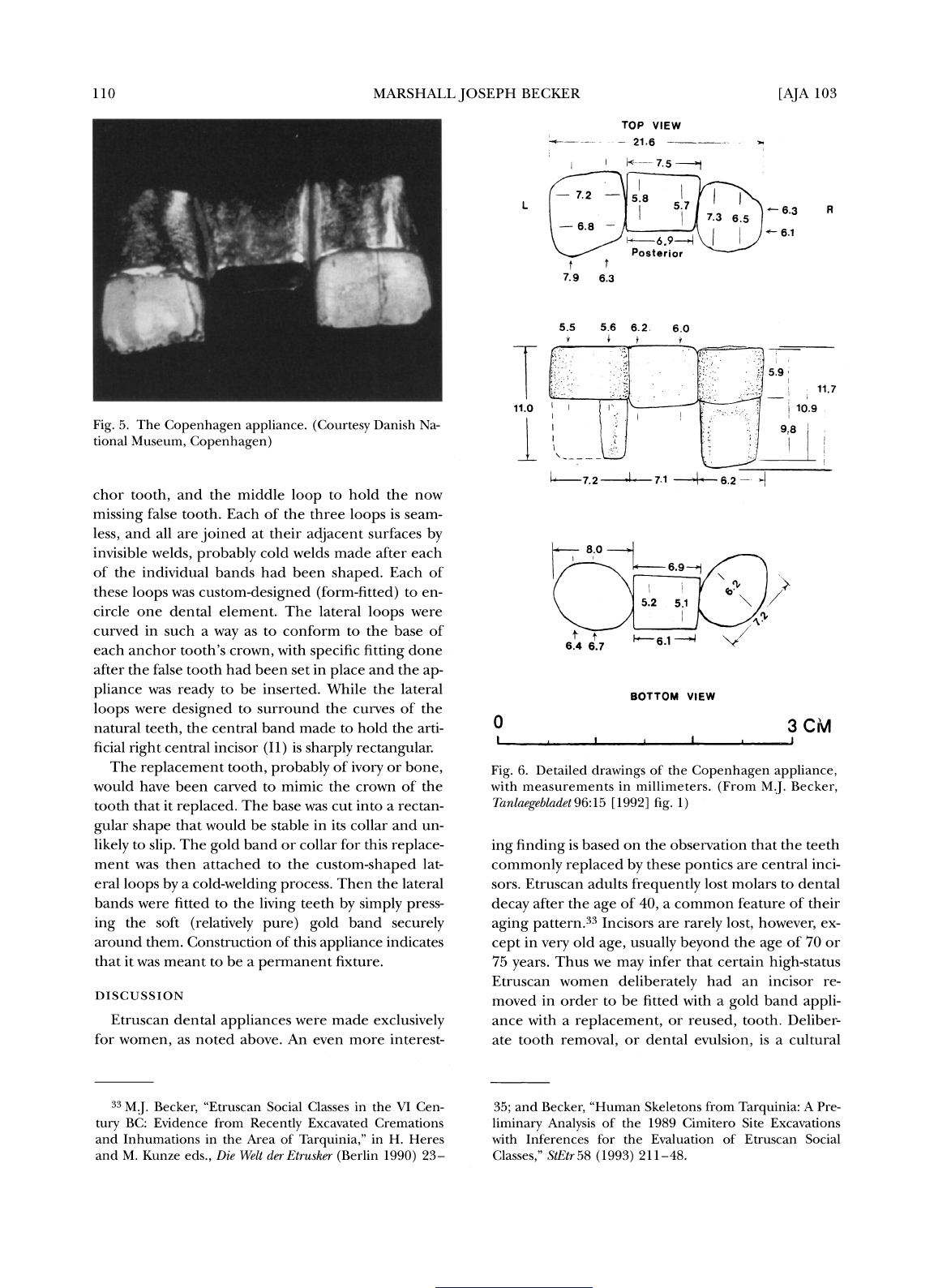
110 MARSHALL
JOSEPH
BECKER
[AJA
103
Fig.
5.
The
Copenhagen
appliance. (Courtesy
Danish Na-
tional
Museum,
Copenhagen)
chor
tooth,
and the
middle
loop
to hold
the now
missing
false tooth. Each
of the three
loops
is seam-
less,
and all are
joined
at their
adjacent
surfaces
by
invisible
welds,
probably
cold
welds
made after each
of the
individual bands had been
shaped.
Each of
these
loops
was
custom-designed
(form-fitted)
to en-
circle one
dental element. The lateral
loops
were
curved
in
such a
way
as to conform to the base of
each anchor
tooth's
crown,
with
specific fitting
done
after
the false tooth had been set
in
place
and the
ap-
pliance
was
ready
to be inserted.
While
the lateral
loops
were
designed
to surround the curves of the
natural
teeth,
the central band made to hold the arti-
ficial
right
central incisor
(11)
is
sharply
rectangular.
The
replacement
tooth,
probably
of
ivory
or
bone,
would have been carved to mimic the crown of
the
tooth that it
replaced.
The base
was
cut into a rectan-
gular shape
that
would
be stable
in
its collar and un-
likely
to
slip.
The
gold
band or collar for
this
replace-
ment
was then attached to the
custom-shaped
lat-
eral
loops
by
a
cold-welding process.
Then the lateral
bands were fitted to the
living
teeth
by simply press-
ing
the soft
(relatively pure) gold
band
securely
around them. Construction of this
appliance
indicates
that
it was meant to be a
permanent
fixture.
DISCUSSION
Etruscan dental
appliances
were made
exclusively
for
women,
as
noted above.
An
even more interest-
ing finding
is based on the observation that the teeth
commonly replaced by
these
pontics
are
central inci-
sors. Etruscan adults
frequently
lost
molars to dental
decay
after the
age
of
40,
a common feature
of
their
aging pattern.33
Incisors are
rarely
lost, however,
ex-
cept
in
very
old
age, usually beyond
the
age
of 70 or
75
years.
Thus we
may
infer that certain
high-status
Etruscan women
deliberately
had an
incisor re-
moved
in
order to
be fitted
with
a
gold
band
appli-
ance with a
replacement,
or
reused,
tooth. Deliber-
ate
tooth
removal,
or dental
evulsion,
is a cultural
TOP VIEW
-
21.6
---
7.5
----8
L
5.7
76.3
R
7.3
6.5
6.8
6.1
Posterior
t
t
7.9
6.3
5.5 5.6
6.2
6.0
11.7
9.8
-7.2
7.1
6.2--
8.o
6.9
5.2
5.1
t
6.1
6.4
6.7
BOTTOM VIEW
0
31CM
I
I
I
Fig.
6. Detailed
drawings
of the
Copenhagen appliance,
with measurements
in
millimeters.
(From
M.J.
Becker,
Tanlaegebladet
96:15
[1992]
fig.
1)
33
M.J.
Becker,
"Etruscan Social Classes
in
the VI Cen-
tury
BC:
Evidence from
Recently
Excavated Cremations
and
Inhumations
in
the Area of
Tarquinia,"
in
H. Heres
and
M.
Kunze
eds.,
Die Welt der Etrusker
(Berlin
1990)
23-
35;
and
Becker,
"Human Skeletons from
Tarquinia:
A
Pre-
liminary Analysis
of the
1989
Cimitero Site Excavations
with Inferences for the Evaluation of Etruscan Social
Classes,"
StEtr58
(1993)
211-48.
This content downloaded from 144.26.117.20 on Thu, 14 May 2015 18:13:01 UTC
All use subject to JSTOR Terms and Conditions

1999]
ETRUSCAN GOLD DENTAL APPLIANCES
pattern
known from
many
areas in
antiquity,
includ-
ing Italy,
that survives
in
many parts
of the
world
to-
day.34
That this
cultural
pattern
of
tooth removal
and elaborate
replacement
with
gold fittings
was
part
of
the southern Etruscan cultural tradition
is
strongly
indicated
by
the distribution of
these
finds
as
well as
the
decline
in
their use as Etruscan
cities,
writing,
and
culture
were absorbed into
the
growing
Roman
empire.
DEPARTMENT OF ANTHROPOLOGY
WEST
CHESTER UNIVERSITY
OF
PENNSYLVANIA
WEST
CHESTER,
PENNSYLVANIA
19383
34J.
Robb,
"Intentional Tooth
Removal
in
Neolithic Ital-
ian
Women,"
Antiquity
71
(1997)
659-69;
and
M.J.
Becker,
"Tooth
Evulsion
among
the Ancient
Etruscans,"
Dental An-
thropology
Newsletter9:3
(1995)
8-9.
This content downloaded from 144.26.117.20 on Thu, 14 May 2015 18:13:01 UTC
All use subject to JSTOR Terms and Conditions
